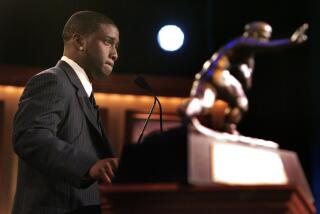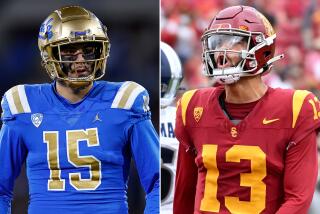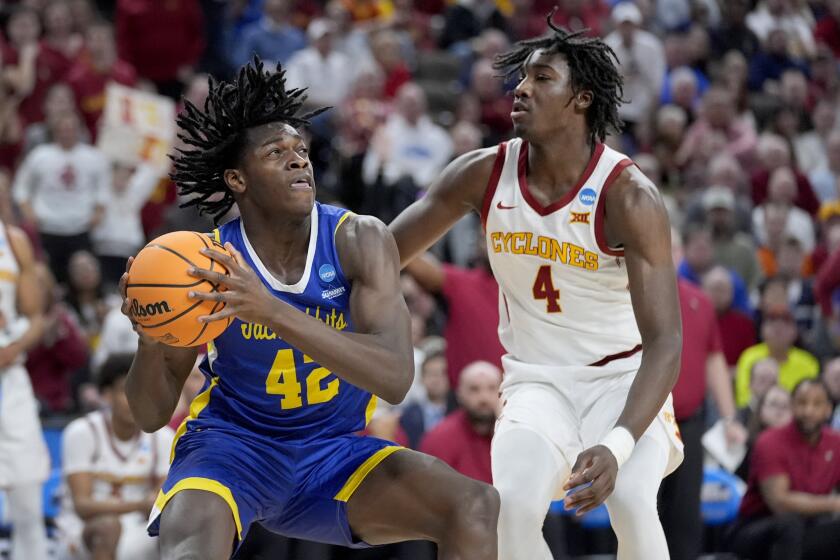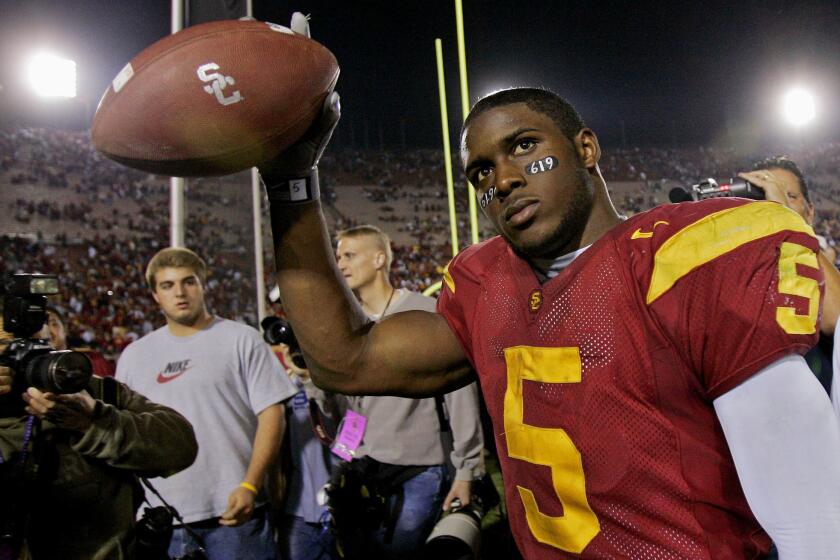CRAIG LEFFERTS : Padre Reliever Has Met Many Challenges On His Way to Becoming a Major Leaguer
Padre reliever Craig Lefferts isn’t just left-handed. He’s also left-eyed.
He cannot use his right eye. When he’s on the mound, he sees the batter only through his left eye, which means it wouldn’t matter at all if he closed his other eye while he pitched. But if he closed his left eye, he’d only see the third base coach. His right eye wanders. It is absolutely useless.
“Didn’t you know that?” Lefferts said recently, his left eye looking out to center field, his right eye looking to right. “The guys are always kidding me. I’ve just got a lazy right eye.”
And although this obviously hasn’t affected his career with the Padres, it has deterred his life. He had practically given up on baseball many years ago, because he was a wimp and because he figured he had no future. He had wanted to attend the Air Force Academy out of high school, but his eye kept looking into right field during the eye examination. He failed and was turned down.
And he has been turned down many other times, not just because of his eye. He has been cut from his high school baseball team, his American Legion team and his college team. This was when he was a wimp who threw 70 m.p.h. fastballs.
And he had serious asthma problems, which kept him from baseball until he was 12 years old. His sister, Lynn, and his mom, Bobbie, had similar problems, so he didn’t worry about it. But one day, Lynn, just 18 months younger than Craig, had a sudden asthma attack and died.
These are the reasons Lefferts just happy to be here today. He had been a hero out of the bullpen last year for San Diego, but that’s forgotten, now that he has been quite mediocre this season (3-2, with a 3.75 earned-run average and 1 save).
He realizes he has a new challenge.
For a while, Craig Lefferts was going to be just like his dad, which was a compliment intellectually, but not athletically. Although Ed Lefferts had played football in high school, his future, according to his coaches, wasn’t in sports.
“I am not very coordinated as an athlete,” Ed Lefferts said. “My basketball coach said I had two left feet. I couldn’t run up and down the court without tripping over myself.”
Eventually, Ed Lefferts made good, though. He had gone to the University of Arizona during the Korean War, and joined the ROTC so he wouldn’t have to go overseas. He learned how to fly airplanes instead.
Later, he became a Lieutenant Colonel in the Air Force, which meant he had be stationed in different places frequently. So he and his wife, Bobbie, and their five children (who were born 7 1/2 years apart), traveled. Craig was born in West Germany. Then he lived in Sacramento, Japan, Topeka, Cape Cod, San Diego, then the Tampa area.
When in Tampa he found out he was a wimp.
He had tried out for the American Legion baseball team there, an area rich in baseball talent. He was cut. Too small, said the coach. The next year, he was the last cut, but another boy quit, and the coach brought him back.
In high school, he’d been cut as as sophomore, and when he finally made the team as a junior, the coach stuck him in right field.
“That’s the spot where they hide you,” he said.
Lefferts weighed 140 pounds, but he thought he could pitch. As he was growing up, he’d tell his dad stories about how he would be a major leaguer someday.
“Fine, son,” said Ed, who believed in dreams.
Lefferts kept begging his coach to let him pitch.
“I’m no right fielder,” he’d say. “I can pitch. Seriously.”
The coach, perhaps a sadist, finally gave in when his regular pitcher became ill, telling Lefferts he could pitch against the defending state champion, Sarasota High.
Lefferts told his dad. He told him he was scared, that he wasn’t sure if he could really pitch, that maybe he’d been lying to himself.
Ed Lefferts: “When your alarm goes off tomorrow morning then, turn it off and roll over. Don’t go. Call the coach and tell him your sick, too.”
Craig: “What! This is my opportunity.”
Ed: “If you’re thinking you can’t win, you won’t win. It’s no use going if you don’t think positive.”
Corny, but sometimes the Father Knows Best approach works.
Lefferts woke up on time and went to the game. He sat on the end of the bench by himself, strange because he clowned around normally. The coach asked him what his problem was.
“Just concentrating, coach,” he said.
He went out, pitched a one-hitter and won 1-0.
“I remember the hit,” he said. “It was a base hit 10 feet over my head. It was a clean hit.”
As a senior, he went 8-3, but no one really noticed. He had his chance to attend Air Force, but failed because of his eye, and Ed wrote to his alma mater (Arizona), asking if it were all right for his son to walk-on to the baseball team. The coach, Jerry Kendall, thought nothing of it, and thought nothing of cutting him a few months later.
“He was skinny, slight and didn’t throw hard,” Kendall said. “I cut him and said ‘Get stronger and we’ll take another look.’ ”
Said Lefferts: “I pitched 10 innings and allowed no earned runs, but I didn’t throw hard. They had recruited a lot of guys, and it came down to me or a freshman on a half-scholarship from California. Guess what?
“I was small, though. You couldn’t tell by looking at me now. I was 5-foot-10, 140 pounds . . . I didn’t throw the ball very hard. I wasn’t impressive looking. But when they gave me a chance, I got people out.”
He had gone back and played Legion ball that summer, thinking he was stronger and faster. But his best fastball was 70 m.p.h.
“I thought I was throwing hard, but the gun doesn’t lie,” he said.
The next year, Lefferts made the junior varsity. Miraculously, he was one of the best pitchers on the varsity the following year. He had grown. He was drafted by the Kansas City Royals, but turned down their offer so he could pitch one more year.
That year, he pitched in the College World Series. The Cubs drafted him.
Major league teams don’t draft wimps.
It’s not clear whether asthma contributed to Lefferts being small as a youngster, but it definitely limited his participation. His first sport had been football, and this was when he was 8 or 9, after his parents said the asthma wasn’t so bad that he couldn’t play.
He later played little league baseball, too, but the two pitchers there (in San Diego) were stoppers, their records being 10-0 and 9-0-1. It was right field for him.
Once in awhile, he’d have asthma attacks, or he’d just wheeze. So did Lynn, although hers always seemed to be worse. They were always on medicine.
His seemed to get better. Hers didn’t. In high school, Lefferts played football, although the grass, the smell of it, made him wheeze.
“In high school football, that was when it was the worst,” he said. “In the grass . . . I couldn’t breathe, and then I’d quit. I caught a lot of flak from the players. If I couldn’t practice, they didn’t want me to play.
“It was all right if I took drugs (medication). If I took those religiously, there wasn’t much trouble with workouts. If I didn’t, I’d always have attacks. And I didn’t always take them. I don’t know why. They make you hyperactive. Sometimes, I just didn’t take them. I don’t know why.”
Lynn took them, but the attacks continued. The family, thinking the Arizona air would be better for her, moved to Tucson.
Meanwhile, Lefferts seemed to outgrow it in college, although he did take an inhaler with him wherever he went. One day, during the year he was on the junior varsity at Arizona, Lynn suddenly died.
His parents think this may have been the difference in Lefferts’ career, the reason he got the inner strength to overcame getting cut and make it to big leagues. He became single-minded toward baseball then. The day after Lynn died, he had been scheduled to pitch against Arizona State, and he still went to the game, saying to his parents that Lynn would have wanted him to pitch.
The teams completed a suspended game, and Lefferts threw four shutout innings. Then, after a half-hour rest, he threw seven innings in a second game. In 11 innings, he yielded three hits and two runs.
“There were times in between innings when she was on my mind,” Lefferts said. “I was wishing she were there. And I still dream about her. We were close. We both had asthma together. We suffered together. I know what it’s like not to breath. She’s free from it now . . . I felt an inner peace because she wouldn’t have to suffer anymore.”
Said Bobbie Lefferts: “You never know, but in Lynn’s death, maybe Craig became better. He knew she’d want him to go on.”
Lefferts: “When something like that happens, it makes you think about how fragile our lives are, and makes you work hard at what you want. It made me pursue my baseball dream.”
Inner strength would carry Craig Lefferts only so far. Sooner or later, he’d be exposed. Sooner or later, the baseball world would discover that he had a mediocre fastball and a mediocre slider.
It happened in the minor leagues, where in Double-A he gave up 25 home runs in 186 innings. In Triple-A he gave up 13 home runs in 95 innings. In his rookie year with the Cubs, he gave up 11 homers in 89 innings.
“That’s more than one homer per nine innings,” he said. “And I was giving them up to right-hand power hitters. I felt I needed a pitch that broke away from right-handers.”
He made it to the majors only because he threw strikes. And he was lucky to be in the majors at all. In 1983, the Cubs had sent him down on the last day of spring training, but Lee Elia, then the manager, walked into Dallas Green’s office and said he needed to go north with Craig Lefferts.
“He was one of those guys who wasn’t overpowering, but he always seemed to get you out,” Elia said.
But that wasn’t enough for Lefferts, whose pitches kept sailing out of the park. He began to experiment with a screwball then, but a lot of good that did. He tried it during one game, and Terry Kennedy hit a home run. He tried it during another game and George Hendrick hit a home run.
Ideally, the screwball is a great pitch to have because it breaks the opposite way of a curveball. It helps left-handed pitchers against right-handed batters. And vice versa. But, if it’s not thrown correctly, it’s worthless.
“Billy Connors (the pitching coach) decided mine was too inconsistent, and said I should concentrate on something else,” Lefferts said.
So he only threw it in the outfield when he’d loosen up before games.
That winter, he went to Puerto Rico for winter ball, and a has-been pitcher named Gil Rondon showed him how he held the screwball, putting pressure on the outside third of the ball with the index finger and using the middle finger merely as a guide. When he released, the ball would spin the opposite way of a curveball, and he wouldn’t have to flick his wrist in an outlandish way to do it.
This was Lefferts’ breakthrough, something he picked up right away. Many pitchers don’t throw screwballs: (a) because it’s normally such a violent motion and they’re afraid of injury and (b) because it takes time and patience to learn it.
Strangely, Lefferts learned to throw it in no time and without injury. The Cubs traded him to the Padres that off-season not knowing what he’d accomplished.
So the Padres had stolen him.
And, during that 1984 season, he had a 2.13 earned-run average and was the winning pitcher in Games 4 and 5 of the National League Championship Series.
“It was the best year of my career,” he said.
And that’s only because of the screwball, the pitch he got all his big outs on. He purposely throws it between 71 and 75 m.p.h., letting gravity do the damage. Only few are able to conquer this pitch. Today, Lefferts says only Fernando Valenzuela and Bill Campbell and himself use it as an out pitch.
“The less guys the better,” he said.
“It’s not a pitch that you learn young. And that’s probably because of the stigma of hurting your arm. People usually don’t use it until they can’t get away with what they’ve got.”
Said Padre Manager Dick Williams: “If he (Lefferts) doesn’t have it, he’s not the quality pitcher that he is.”
Right now, he doesn’t have it. He keeps hanging it. Andre Dawson had an important RBI against a screwball just last week. But it also should be known that Lefferts has had tendinitis problems in his left elbow since spring training.
And only now does he feel better. In the outfield, you can see him playing catch with a teammate, and he’s throwing screwball, screwball, screwball, the ball bouncing at the other guy’s right shoelace. Craig Lefferts is battling.
Again.
‘There were times in between innings when she (younger sister Lynn) was on my mind. I was wishing she were there. And I still dream about her. We were close. We both had asthma together. We suffered together. I know what it’s like not to breath. She’s free from it now . . . I felt an inner peace because she wouldn’t have to suffer anymore.’
--Craig Lefferts
More to Read
Get our high school sports newsletter
Prep Rally is devoted to the SoCal high school sports experience, bringing you scores, stories and a behind-the-scenes look at what makes prep sports so popular.
You may occasionally receive promotional content from the Los Angeles Times.






